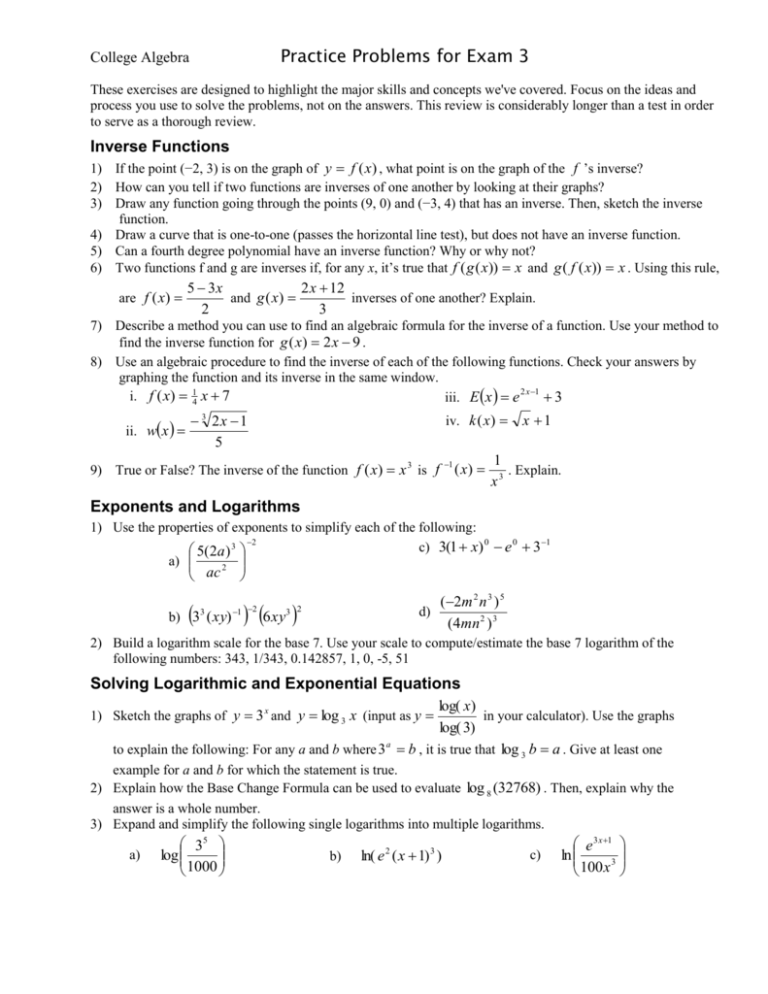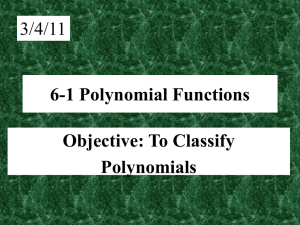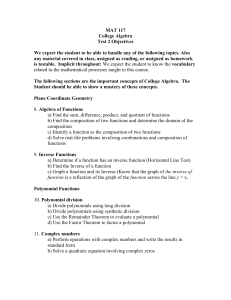This optional review activity is designed to highlight the major skills
advertisement

Practice Problems for Exam 3 College Algebra These exercises are designed to highlight the major skills and concepts we've covered. Focus on the ideas and process you use to solve the problems, not on the answers. This review is considerably longer than a test in order to serve as a thorough review. Inverse Functions 1) If the point (−2, 3) is on the graph of y f (x) , what point is on the graph of the f ’s inverse? 2) How can you tell if two functions are inverses of one another by looking at their graphs? 3) Draw any function going through the points (9, 0) and (−3, 4) that has an inverse. Then, sketch the inverse function. 4) Draw a curve that is one-to-one (passes the horizontal line test), but does not have an inverse function. 5) Can a fourth degree polynomial have an inverse function? Why or why not? 6) Two functions f and g are inverses if, for any x, it’s true that f ( g ( x)) x and g ( f ( x)) x . Using this rule, are f ( x) 5 3x 2 x 12 and g ( x) inverses of one another? Explain. 2 3 7) Describe a method you can use to find an algebraic formula for the inverse of a function. Use your method to find the inverse function for g ( x) 2 x 9 . 8) Use an algebraic procedure to find the inverse of each of the following functions. Check your answers by graphing the function and its inverse in the same window. i. f ( x) 14 x 7 iii. E x e 2 x 1 3 ii. w x iv. k ( x) 3 2x 1 5 1 9) True or False? The inverse of the function f ( x) x 3 is f ( x) x 1 1 . Explain. x3 Exponents and Logarithms 1) Use the properties of exponents to simplify each of the following: 2 c) 3(1 x) 0 e 0 31 5(2a ) 3 a) 2 ac 3 b) 3 ( xy) 6xy 1 2 3 2 d) (2m 2 n 3 ) 5 (4mn 2 ) 3 2) Build a logarithm scale for the base 7. Use your scale to compute/estimate the base 7 logarithm of the following numbers: 343, 1/343, 0.142857, 1, 0, -5, 51 Solving Logarithmic and Exponential Equations log( x) in your calculator). Use the graphs log( 3) a to explain the following: For any a and b where 3 b , it is true that log 3 b a . Give at least one 1) Sketch the graphs of y 3 x and y log 3 x (input as y example for a and b for which the statement is true. 2) Explain how the Base Change Formula can be used to evaluate log 8 (32768) . Then, explain why the answer is a whole number. 3) Expand and simplify the following single logarithms into multiple logarithms. a) 35 log 1000 b) ln( e 2 ( x 1) 3 ) c) e 3 x 1 ln 3 100 x Practice Problems for Exam 3 College Algebra 4) Solve each of the following for x. a) log 3 (27) x g) 1 3 b) ln( x ) 1 3 x 3 h) 5 x 2145 c) ln( e 9 ) x i) 13 2e x 1 25 1 d) log x 2 9 j) log 3 ( x 2 1) log 3 (8) k) log 2 ( x) log 2 (11) log 2 (3) x 3 2 8 e) log 4 l) ln( x 4) 2 ln( 3) ln( x) f) 2 3 x 1 2 3 5) Solve for Z: 1 e 2 Z 5 8 11 Applications of Exponentials and Logs 1) List the formulas for one-time investments involving continuously and periodically compounded interest. Describe what each of the variables and constants mean in the formulas. 2) Suppose you need to borrow $10,000 from your Uncle Benny, who gives you two options. The Premium Plan comes with an interest rate of 13% , compounded quarterly, for 5 years. The Elite Plan has an APR of 8%, compounded continuously for 8 years. Which plan would you choose and why? 3) How much money must you invest if you want $7,000 30 years from now? Assume the investment has a 6% annual interest rate and is compounded semi-annually. 4) At what interest rate must you invest in order to grow $800 to $2,200 in 9 years, compounded continuously? What about if the investment is compounded monthly? 5) On January 1st, 2006, Ned put $5000 in a hole in the ground. He put an additional $800 into an investment with an interest rate of 5%, compounded continuously. Ignoring inflation, on what month of which year will Ned's investments (both above and below ground) have a total value of $15,000? 6) Describe a general process by which a forensics expert might go about estimating time of death using body temperature recordings. 7) One model for the population P (x ) of the world in year x is P( x) .0051e .0139x . a) Estimate the population in x=1800 and 2005. (The UN estimates are 980 million and 6.4 billion.) b) According to the model, what is the exact date when the world population will be 7,000,000,000? 8) The following table shows the concentration of hydrogen ions (labeled [ H ] ) in a beaker as drops of the chemical NaOH are added to an HCl solution. Drops of NaOH 100 180 190 198 200 204 300 [H ] 3.0 10 1 5 10 2 2.5 10 2 5 10 3 2 10 6 1 10 9 5 10 13 pH a) Does the concentration of hydrogen ions increase or decrease as NaOH is put into the beaker? b) Using the formula pH log([ H ]) , fill in the pH values in the table. c) How many drops do you think it took for the solution to switch from an acid to a base? (acids are liquids with pH values less than 7) College Algebra Practice Problems for Exam 3 Features of Polynomials 1) What is a polynomial? Give 3 examples and 3 non-examples of polynomials. 2) Is (3,0) an x-intercept of S x 2 x 3 7 x 2 6 x 27 ? Explain how you know for sure. 3) Consider p( x) (2 x 3)( x 2) 3 ( x 3) 2 a) What is the y intercept of this polynomial? b) What are the x intercept(s)? c) Describe the behavior of the graph of y p(x) at each of the x intercepts. d) What is the degree and leading coefficient of p(x). How do these impact the graph of p(x)? e) What are the approximate turning points of the polynomial p? f) Repeat the previous steps for the new polynomial y ( x 5)( x 5) 3 (5 x 12)( x 1) 2 . 4) Describe how the factored form of a polynomial gives information about the x intercepts. Use the graph of W ( x) 2 x 55 x 2 ( x 2)( x 2 ) as an example in your description. 2 5) The fourth degree polynomial f ( x) x 4 x 3 - 37x 2 - 7x 210 can be factored as f ( x) ( x 2 7)( x a)( x b) , where a and b are whole numbers. Use a graph of y f (x) to find a and b and then find all four exact x-intercepts for f(x). 6) What are the possibilities for the number of x intercepts of a 4th degree polynomial? Sketch graphs illustrating the possibilities. 7) What are the possibilities for the number of turning points of a 7th degree polynomial? Sketch graphs illustrating the possibilities. 8) What are the possibilities for the number of inflection points of a 5th degree polynomial? Sketch graphs illustrating the possibilities. 9) Build an equation of some polynomial with x intercepts at ½ and 5 and two turning points. 10) Build a plausible equation for the 8th degree polynomial pictured below.









